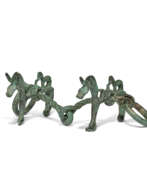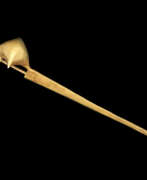Villanova culture

Villanova culture
The Villanova culture, dating from around 900 to 700 BC, marks the earliest phase of the Etruscan civilization and represents the beginning of the Iron Age in Italy. This culture, named after the site of Villanova near Bologna where it was first identified, followed the Bronze Age Proto-Villanovan culture, which was part of the larger Urnfield culture of Central Europe.
The Villanova culture is renowned for its metalwork, particularly in bronze and pottery, reflecting the skill of its artisans. Excavations of burial sites have unearthed grave goods of high quality, suggesting the development of societal elites. Men's graves typically contained weapons and armor, while women's graves included weaving tools, although there were exceptions to these gendered burial practices. This period also saw significant trade interactions with the Mediterranean states such as Greece, the Balkans, and Sardinia, which influenced Villanovan metallurgy and pottery.
Villanovan settlements were primarily located in the Adriatic Etruria, Emilia Romagna, Marche, Tyrrhenian Etruria, Tuscany, and Lazio. The people lived in rectangular huts made of wattle and daub with wooden poles for support. These homes included cooking stands, utensils, and large pottery jars for food storage, offering insights into the family life of early inhabitants in Italy.
The Villanovans practiced cremation, placing the cremated remains in biconical urns, often adorned with simple incised decorations. Some urns were topped with impressive bronze helmets, while others were more simple. The burial practices and accompanying goods indicate a belief in an afterlife and suggest a more complex societal structure with an elite class. Later burials included inhumation in trench tombs, sometimes with couples buried together, indicating evolving practices over time.
The Villanova culture is considered to be the precursor to the Etruscan civilization. It underwent an 'orientalising' process, influenced by contact with Greece, Phoenicia, and the Near East, leading to the evolution of the Etruscan culture. This transition, marked by changes in art and culture, was complete by the early 7th century BCE in the south of Etruria and persisted in northern Italy until the 6th century BCE.
For collectors and enthusiasts of ancient art and antiques, the Villanova culture offers a fascinating glimpse into the early stages of the Etruscan civilization and the dawn of the Iron Age in Italy. To stay informed about discoveries and events related to this intriguing period, sign up for our updates, and we'll ensure you're always in the know about the latest in this field.
| Country: | Europe, Italy |
|---|---|
| Start of the period: | 900 BC |
| End of the period: | 700 BC |


